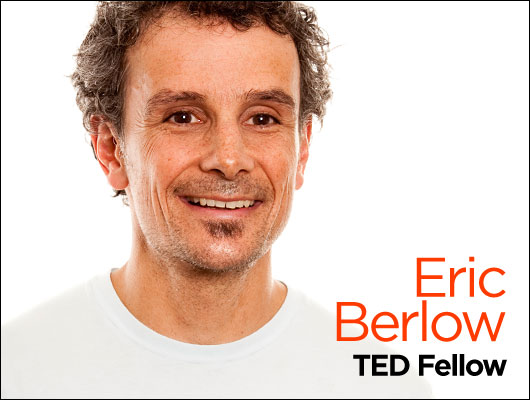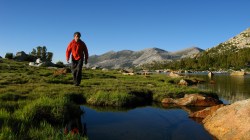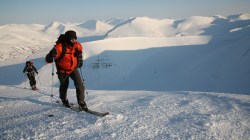 Positive feedback loops can be found in even the messiest conflicts, ecosystems and corporations, according to Eric Berlow. The trick, he tells TED, is to not confuse the means with the ends.
Positive feedback loops can be found in even the messiest conflicts, ecosystems and corporations, according to Eric Berlow. The trick, he tells TED, is to not confuse the means with the ends.Interactive Fellows Friday Feature:
Join the conversation by answering Fellows’ weekly questions via Facebook. This week, Eric asks:
Instead of narrow specialization, how can our educational system better train integrative, innovative, and adaptive problem solvers?
Starting Saturday, click here to respond!
You work on problems from a “network” or “systems” perspective. How has this practice evolved for you?
In the past, I’ve mostly focused on networks in nature: how species are interconnected. Then I began to see how networks could be applied more generically, and I got very interested in the potential applications network thinking had to other types of complex problems.
What are some of the complex problems you are working on now?
Currently, I’m working for a foundation on mapping the structure of successful non-violent movements in the Middle East. In particular, we’re focusing on the Israeli-Palestinian conflict. What are all the moving parts of a successful non-violent movement? How are they all related? Are there some positive feedback loops, with points of entry that we haven’t thought of before?
I have also been working with a large corporation on the future energy supply and it’s relation to food and water security. If, for example, we replaced all fossil fuels with bio-fuels, they would conflict with land for food production. And if we powered everything with electricity, that would strain water resources, because a lot of electrical production, even renewable electricity, is water-use intensive. There’s a lot of interest in mapping out how we can meet our need for energy, food and water simultaneously.
Additionally, I’ve just started collaborating with an interesting start-up, Open Data Registry, on sustainable supply chains. For example, we worked with data from Patagonia’s Footprint Chronicles project. For a number of their clothing articles, you can go online and trace where the raw materials came from, how much energy and carbon emissions were expended, how much waste was produced, etc. We compiled all the data for all the supply chains of every product and mapped it as a clothing ‘ecosystem’. Then you can visualize the entire web for the whole corporation, and see which one aspect of the whole production would have the most impact in increasing efficiency for the entire company. Maybe there’s one factory or shipping route that, with increased efficiency, would change everything down the line from there.
To me, the most interesting thing about diving in to complex problems is that, on the one hand, one problem leads to many problems, but that also means that a single solution can cause many solutions.
I can think of lots of situations where one problem causes many others. Can you give an example where one solution causes many more solutions?
Some time ago I designed and built a house in the Eastern Sierra Nevada. I wanted it to be sustainably designed, but I had a very tight budget. It’s really a whole complex system of trying to figure out how to get the biggest bang for your buck when building a green home.
Many people would ask me, “Did you put in solar panels for electricity?” But actually, when you look at the whole system, that’s the last thing I’d do to get the most for my money. It turns out that the most important thing for achieving low-cost sustainable design is having a small place, that’s well insulated, with windows and overhangs in the right place for that location and climate.
The second biggest controllable cost was heating for the building, and for water. In that case, the cheapest thing was, in fact, to have solar thermal panels to heat water. The water goes through the concrete floors, the sun heats the concrete floors in the day in the wintertime, it heats the shower water, and also heats the hot tub on the way back. So, with one pretty low-tech and cheap system, I’m heating the house, the shower, and the hot tub — while saving hundreds of dollars a month in the wintertime on propane. I’d choose solar panels for electricity last, because with efficiency efforts my electricity bill is only $30 a month.
I give that example, because most people initially focus on the means, rather than the end goal. Amory Lovins has a great quote: “People don’t want gas and electricity. They just want hot showers and cold beer.” In my case, my goal was: comfortable temperature inside, with the minimum amount of energy input and a minimum cost.
So what’s your advice for the Average Joe who is overwhelmed by a complex problem?
Well, you can map things out till the cows come home, but as the Amory Lovins quote illustrates, if you don’t really know what your goals are, then there’s no point to it. More often than not, people get overwhelmed because they’re confused about what their goal is. They conflate a goal with an implementation strategy. A perfect example of that is when people have a goal to be happy, and they think the way to get there is to make more money. So making money becomes the goal, and they forget the goal was to be happy. Then they wonder why they’re disappointed later.
Do you actually use the kind of visual map that you used in your TEDTalk to solve the problems you work on?
Yes, though before I had those tools I did it more by hand.
The kinds of tools that I use now were developed by my good friend and colleague for food web visualization. If you have more than 10 or 15 moving parts, you can’t really visualize that in your head. When you have 100 moving parts that’s 10,000 possible connections, and it really pays to have some aid to plot it all out and let the patterns emerge out of the pile.
Once all those things are all plotted, the human brain is really good at detecting patterns visually. Think about how, in a room of 100 people, you can pretty quickly and instantly tell the difference between everybody’s face. Those are amazing visual recognition skills.
I do a lot of plotting of the who’s connected to who stuff visually, turn it upside down, look at it in different ways, and order it in different ways. That way I can quickly see where clusters emerge, where things pop out at the center, which are the most important, and that sort of thing.
There are many aspiring social entrepreneurs out there who are trying to take their passion and ideas to the next level. What is one piece of advice you would give to them based on your own experiences and successes? Learn more about how to become a great social entrepreneur from all of the TED Fellows on the Case Foundation’s Social Citizens blog.
I’ve been an academic researcher for years. But I have been seeing so much innovation and potential in the private sector. So a couple weeks ago I quit my university job in order to pursue these things more seriously. It’s scary, because I know how academia works, and it’s pretty secure, but I was feeling a little bit constrained in my ability to be creative and take risks.
So I’m just kind of jumping out there into the unknown. The main thing that I’m trying to focus on is my values. There’s definitely temptation and opportunities to just make money applying my skills. But I keep realizing that I really only want to work on projects that I feel have potential for exceptional social or environmental good. So remember to stick to your values and what’s really exciting to you. The more excited you are, the better you’ll do, and you’ll have infectious enthusiasm about what you do.
The other thing is, I’ve found doing my research that I’m most successful when I’m doing projects with people that I really like to work with. Life is short. We spend a lot of our time working. We may as well be working with people that are really fun, exciting and inspiring to work with.
Besides working, you also spend a lot of your time skiing. Why are you so dedicated to it?
I do spend a lot of time in the Sierra Nevada skiing, and I would say most of my good, creative ideas come while I’m skiing uphill. To ski uphill, you put what are called “skins” on the bottom of our skis, and your heel is free, so you walk uphill with your skis, take the skins off, and ski down.
I’m a very kinetic thinker … my entire mini-TEDTalk was written in my head while I was walking uphill. And I pretty much wrote all of the paper for my thesis that was published in Nature while skiing uphill.
How did the idea for your TED Fellows retreat, “Think Weird Go Big” get generated?
TED2010 was amazing and I loved it. Afterwards, I realized that my favorite part was actually meeting the other Fellows. I realized that as a group we were all doing such different things, but everybody was taking their little project to the next level, trying to go bigger with it. And it made me think, “I can do that, too.” That’s how Jessica Green (another TED Fellow) and I came up with the Think Weird Go Big project. The idea was to have a small self-coaching retreat to support each other in reaching our next goals.
We’re all at a place in our lives where we have similar kinds of constraints and obstacles. By hearing about one person getting past their obstacles, everybody else gets something out of it. Living together, cooking meals together and getting to know each other in that intimate setting, even for just a few days, makes it extremely easy to follow up with each other for advice and even collaborations .
My personal project that I discussed at Think Weird Go Big was figuring out how to use my background in ecology and network theory and apply it for social and environmental good in the private sector.
I also got feedback on the company I’m going to start, called Brazil Nut Effect. The name refers to when you shake a pile of mixed nuts and the large Brazil nuts rise to the surface. The company will create tools to help the important nuggets emerge out of the mess. I feel like I’m just at the beginning of this new phase in my life, and that’s pretty exciting.


Comments (2)
Pingback: Learning by speedyf1 - Pearltrees